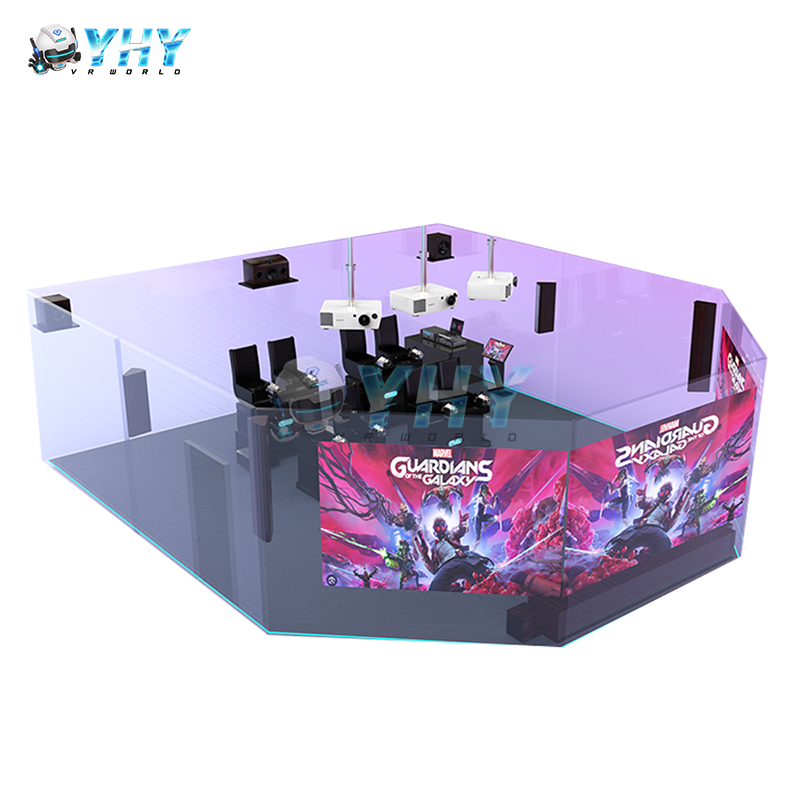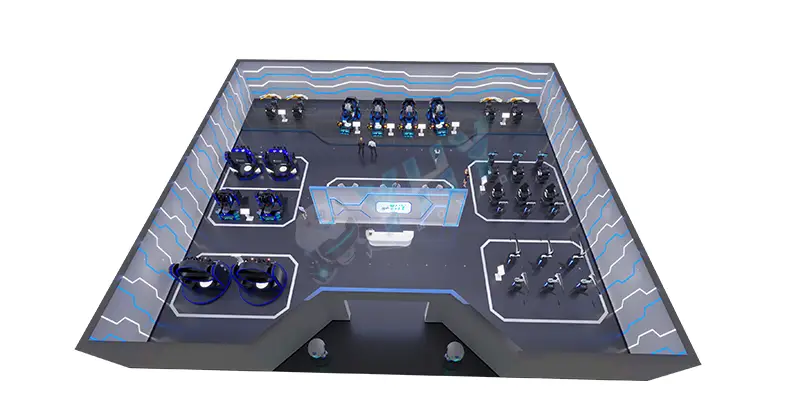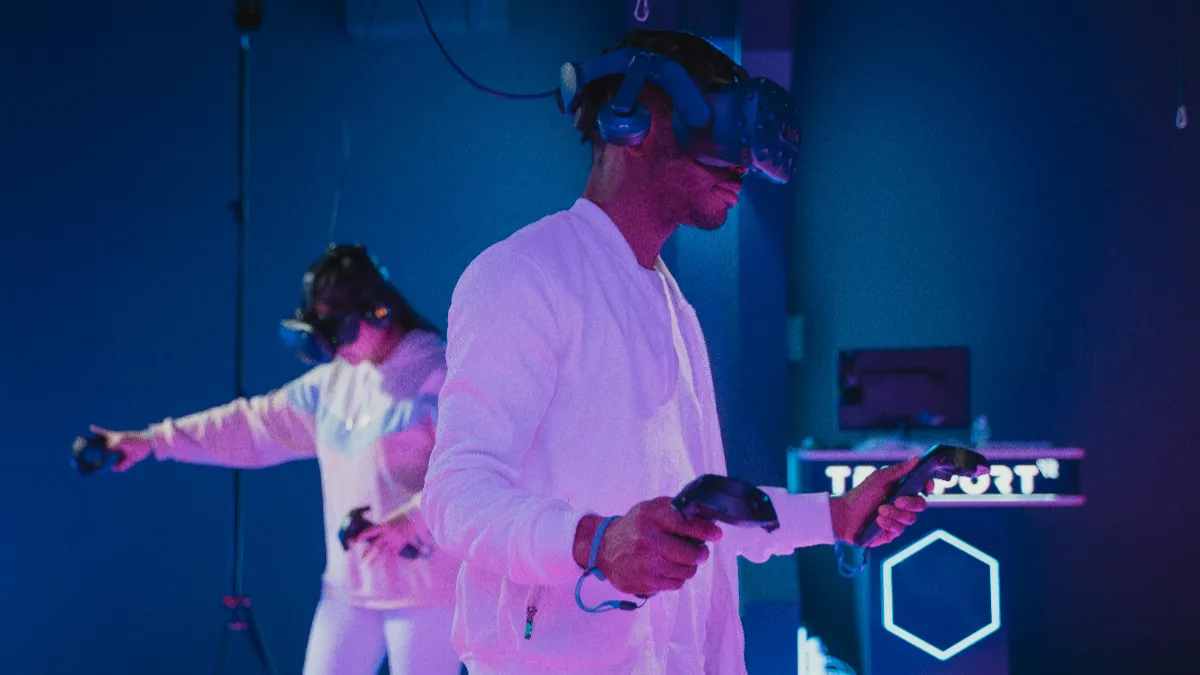आभासी वास्तविकता (वी.आर) प्रौद्योगिकी सिर्फ एक भविष्यवादी विचार से कहीं अधिक है. आज की कारोबारी दुनिया में, यह उन कंपनियों के लिए एक आवश्यक उपकरण बनता जा रहा है जो आगे रहना चाहती हैं. ग्राहक अनुभव बढ़ाने से लेकर आंतरिक प्रक्रियाओं में सुधार तक, व्यवसाय में वीआर तकनीक तेजी से उद्योगों को बदल रही है. इसलिए, आइए देखें कि व्यवसाय अपनी दक्षता और प्रदर्शन को बढ़ावा देने के लिए वीआर का लाभ कैसे उठा रहे हैं.
वीआर तकनीक क्या है
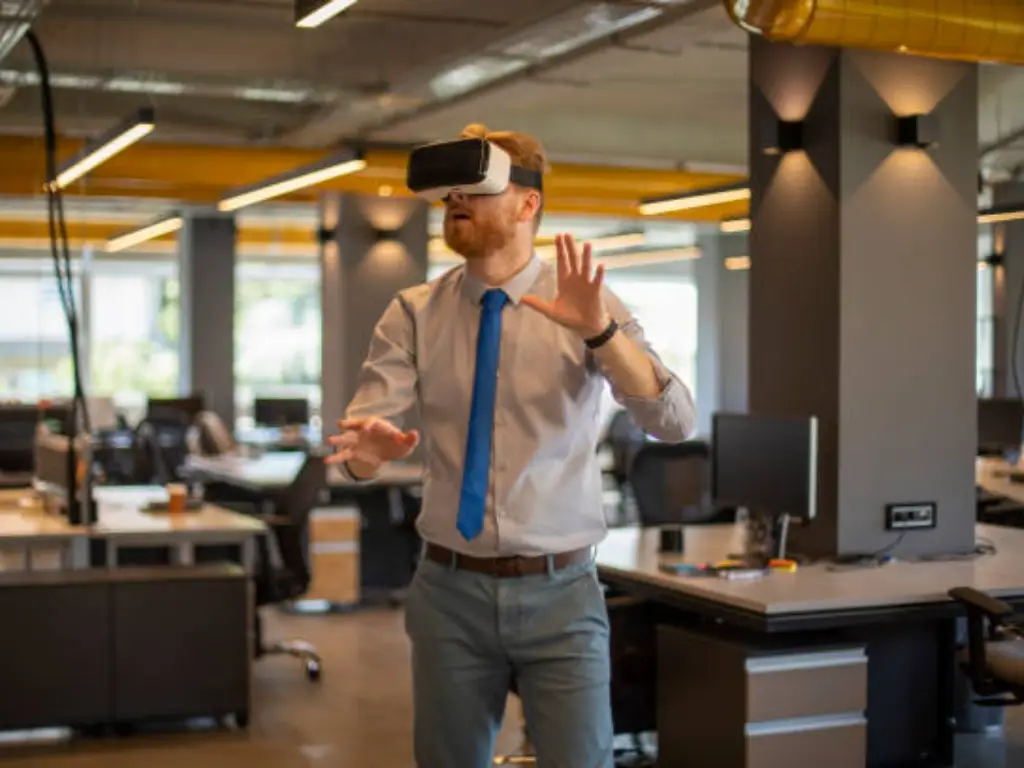
आभासी वास्तविकता (वी.आर) एक कंप्यूटर-जनित वातावरण है जो वास्तविक या काल्पनिक दुनिया का अनुकरण करता है. इसमें व्यापक अनुभव प्रदान करने के लिए आमतौर पर वीआर हेडसेट और नियंत्रक जैसे विशेष उपकरणों की आवश्यकता होती है. पारंपरिक मीडिया के विपरीत, जहां आप केवल सामग्री का अवलोकन कर रहे हैं, वीआर आपको सीधे कार्रवाई में रखता है, आपको पर्यावरण का हिस्सा होने का एहसास कराता है.
तल्लीनता की यह भावना ही VR को व्यवसाय जगत में गेम-चेंजर बनाती है. सही वीआर तकनीक के साथ, व्यवसाय ऐसे इंटरैक्टिव अनुभव बना सकते हैं जो ग्राहकों और कर्मचारियों को समान रूप से संलग्न करते हैं, उन तरीकों से जो पारंपरिक तरीकों से असंभव होंगे.
लेकिन यहाँ मुख्य बात यह है कि वीआर अब केवल एक "कूल" तकनीकी प्रवृत्ति नहीं रह गई है. यह अब एक शक्तिशाली व्यावसायिक उपकरण है. चाहे वह प्रशिक्षण कर्मचारियों के लिए हो, उत्पादों का प्रदर्शन, या ग्राहक सेवा में सुधार करना, व्यवसाय में वीआर तकनीक एक मूल्यवान संपत्ति है जिसे कई उद्योग अपनाने लगे हैं.
व्यावहारिक तरीके से व्यवसाय वीआर प्रौद्योगिकी को एकीकृत कर रहे हैं
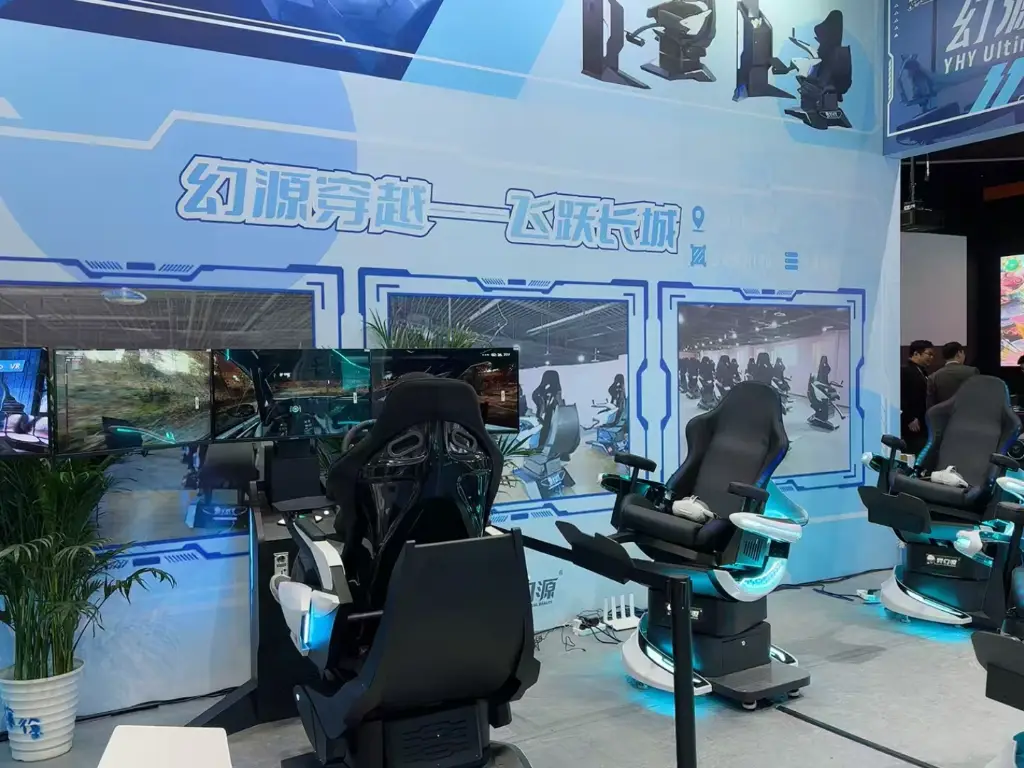
इसलिए, व्यवसाय वास्तव में VR का उपयोग कैसे कर रहे हैं?? यहाँ हैं 5 व्यवसायों में वीआर को शामिल करने के तरीके:
1. वीआर के साथ पर्यटन उद्योग में क्रांति लाना
पर्यटन उद्योग ने वीआर तकनीक का रचनात्मक उपयोग ढूंढ लिया है, संभावित पर्यटकों को यात्रा से पहले गंतव्यों का गहराई से अनुभव करने का अवसर प्रदान करना. इसका एक उल्लेखनीय उदाहरण YHY है चौराहा 2 वीआर मोशन सिम्युलेटर. YHY ने अपने बीजिंग ग्रेट वॉल प्रोजेक्ट के साथ एक अनोखा अनुभव बनाया, जहां आगंतुक वीआर मोशन सिम्युलेटर में बैठते हैं जो उन्हें वस्तुतः अनुमति देता है “पार करना” चीन की महान दीवार.
यह अनुभव, YHY की VR तकनीक द्वारा संचालित, गति और गहराई का एहसास प्रदान करता है, उपयोगकर्ताओं को महान दीवार पर चलने का ऐसा एहसास दे रहा है मानो वे वास्तव में वहां हों. वीआर के साथ गति सिमुलेशन को एकीकृत करके, YHY उन लोगों के लिए एक गहन और यथार्थवादी अनुभव बनाता है जो कभी भी व्यक्तिगत रूप से महान दीवार का दौरा करने में सक्षम नहीं हो सकते हैं. वीआर का यह अभिनव उपयोग न केवल पर्यटन को बढ़ावा देता है बल्कि दुनिया के आश्चर्यों को उन लोगों तक भी पहुंचाता है जो अन्यथा चूक जाते.
2. आभासी उत्पाद प्रदर्शन
वीआर का सबसे प्रभावशाली उपयोग उत्पाद प्रदर्शन में है. एक गहन अनुभव प्रदान करके, कंपनियां अपने उत्पादों को यथार्थवादी माहौल में प्रदर्शित कर सकती हैं. उदाहरण के लिए, बीएमडब्ल्यू ने अपने वाहनों की वर्चुअल टेस्ट ड्राइव की पेशकश करने के लिए वीआर तकनीक को शामिल किया है. संभावित खरीदार डीलरशिप पर वीआर हेडसेट का उपयोग कर सकते हैं, जिससे उन्हें कार में पैर रखे बिना बीएमडब्ल्यू चलाने का अनुभव प्राप्त हो सके. यह गहन अनुभव खरीदारी संबंधी निर्णय लेने में उपभोक्ता का विश्वास बढ़ाने में मदद करता है.
3. प्रशिक्षण एवं कौशल विकास
वीआर तकनीक विभिन्न उद्योगों में प्रशिक्षण कार्यक्रमों में क्रांति ला रही है. वॉलमार्ट प्रशिक्षण कार्यक्रम इसका प्रमुख उदाहरण है, जहां वीआर मॉड्यूल कर्मचारियों को आभासी परिदृश्यों में डुबो देते हैं. वॉल-मार्ट उच्च दबाव वाली स्थितियों का अनुकरण करने के लिए वीआर को नियोजित किया है, जैसे कि ब्लैक फ्राइडे कार्यक्रमों के दौरान व्यस्त बिक्री स्तर को संभालना. यह पद्धति कर्मचारियों को जोखिम मुक्त वातावरण में अभ्यास करने और अपने कौशल को निखारने की अनुमति देती है, जो प्रशिक्षण लागत को काफी कम करता है और सीखने के परिणामों को बढ़ाता है. वॉलमार्ट के अनुसार, वीआर में प्रशिक्षण से कर्मचारियों की तैयारी में सुधार हुआ है 10% पारंपरिक प्रशिक्षण विधियों की तुलना में.
4. उत्पाद विकास और प्रोटोटाइप को सुव्यवस्थित करना
विनिर्माण और डिज़ाइन जैसे उद्योगों में, उत्पाद विकास में वीआर एक मूल्यवान उपकरण साबित हो रहा है. कंपनियां उत्पादों के डिजिटल प्रोटोटाइप बना सकती हैं और भौतिक मॉडल बनाने से पहले आभासी परीक्षण कर सकती हैं. इससे महंगे प्रोटोटाइप की आवश्यकता कम हो जाती है और व्यवसायों को विभिन्न पुनरावृत्तियों का अधिक कुशलता से परीक्षण करने की अनुमति मिलती है.
उदाहरण के लिए, फोर्ड मोटर कंपनी कार प्रोटोटाइप को डिजाइन और परीक्षण करने के लिए वीआर का उपयोग करती है. इंजीनियर वस्तुतः एक डिजिटल कार मॉडल के माध्यम से चल सकते हैं, समायोजन करें, और अनुकरण करें कि घटक एक साथ कैसे काम करते हैं, सभी एक आभासी स्थान में. यह विधि भौतिक प्रोटोटाइप के निर्माण से जुड़े समय और लागत को काफी कम कर देती है. वीआर को अपनाकर, फोर्ड न केवल पैसा बचाता है बल्कि विकास प्रक्रिया को भी तेज करता है, उत्पादों को तेजी से बाजार में पहुंचाना.
5. वीआर के साथ शिक्षा क्षेत्र में क्रांति लाना
वीआर के एकीकरण से शिक्षा क्षेत्र को भी लाभ हो रहा है, जो गहन शिक्षण अनुभव प्रदान कर सकता है जो पारंपरिक तरीके नहीं कर सकते. वीआर छात्रों को जटिल विषयों का पता लगाने की अनुमति देता है, इतिहास से विज्ञान तक, अधिक आकर्षक तरीके से. वस्तुतः ऐतिहासिक स्थलों का दौरा करके या अणुओं के 3डी मॉडल के साथ बातचीत करके, शिक्षार्थियों को सामग्री की गहरी समझ प्राप्त होती है.
इसका एक उदाहरण लैबस्टर है, एक कंपनी जिसने विज्ञान पढ़ने वाले छात्रों के लिए वर्चुअल लैब विकसित की है. लैबस्टर की वीआर लैब छात्रों को आभासी वातावरण में प्रयोग करने की अनुमति देती है, जहां वे बिना किसी जोखिम के रसायनों या जटिल वैज्ञानिक उपकरणों के साथ सुरक्षित रूप से जुड़ सकते हैं. इससे छात्रों को व्यावहारिक अनुभव मिलता है और उनकी समझ गहरी होती है, यह सब एक आभासी कक्षा में रहते हुए. लैबस्टर के वीआर सिमुलेशन को छात्र सहभागिता और सीखने के परिणामों में सुधार करने के लिए दिखाया गया है, साथ ही संस्थानों को व्यावहारिक विज्ञान शिक्षा के लिए अधिक लागत प्रभावी समाधान प्रदान करता है.
व्यवसाय संचालन में वीआर प्रौद्योगिकी का उपयोग करने के मुख्य लाभ
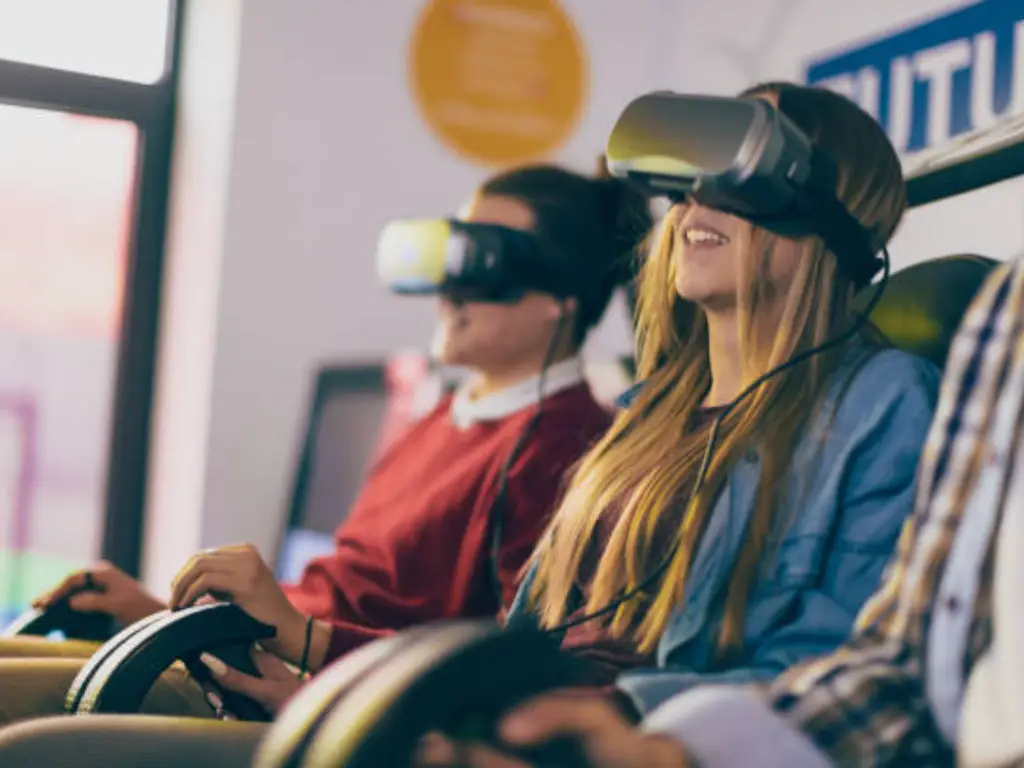
व्यवसाय संचालन में वीआर प्रौद्योगिकी के उपयोग के लाभों को नजरअंदाज करना कठिन है. आइए उन्हें तोड़ें:
- बढ़ी हुई दक्षता: वीआर पारंपरिक प्रक्रियाओं से जुड़े समय और लागत को कम करता है. इस बारे में सोचें कि छायांकन या नौकरी पर प्रशिक्षण के पुराने तरीकों की तुलना में आभासी वातावरण में किसी को प्रशिक्षित करना कितना तेज़ है. वीआर कर्मचारियों को अधिक प्रभावी ढंग से और कम समय में प्रशिक्षित करना संभव बनाता है.
- बेहतर ग्राहक सहभागिता: वीआर के साथ, व्यवसाय अपने ग्राहकों को ऐसे अनुभव प्रदान कर सकते हैं जो पारंपरिक मीडिया के साथ वे जो कुछ भी कर सकते हैं उससे कहीं अधिक आकर्षक हैं. चाहे वह ग्राहकों को वस्तुतः उत्पादों को आज़माने देना हो, एक सेवा का अनुभव करें, या बस ब्रांड के साथ अधिक गहन तरीके से बातचीत करें, वीआर ग्राहकों को लंबे समय तक व्यस्त रखने में मदद करता है, जो उच्च संतुष्टि और बिक्री में परिवर्तित होता है.
- बेहतर निर्णय लेना: वीआर व्यवसायों को निर्णय लेने से पहले विभिन्न परिदृश्यों का अनुकरण करने की क्षमता प्रदान करता है. उदाहरण के लिए, आर्किटेक्ट किसी भवन के निर्माण से पहले ही उसका डिज़ाइन देख सकते हैं, उन्हें संभावित मुद्दों की शीघ्र पहचान करने की अनुमति देना. उसी प्रकार, उत्पाद विकास के लिए वीआर तकनीक में निवेश करने वाले व्यवसाय भौतिक रूप से निर्माण की आवश्यकता के बिना प्रोटोटाइप का परीक्षण कर सकते हैं.
- लागत बचत: वीआर लंबे समय में लागत को काफी कम कर सकता है. प्रशिक्षण सिमुलेशन, उदाहरण के लिए, प्रशिक्षक लाने या वास्तविक दुनिया में होने वाली गलतियों से निपटने की तुलना में ये कहीं अधिक सस्ते हैं. इसके अतिरिक्त, वीआर-संचालित डिज़ाइन व्यवसायों को उत्पादन के लिए प्रतिबद्ध होने से पहले डिज़ाइन का परीक्षण और संशोधन करने की अनुमति देकर प्रोटोटाइप की लागत में कटौती कर सकता है.
वीआर को अपनाकर, व्यवसाय न केवल अपनी आय में सुधार कर रहे हैं - वे प्रशिक्षण से लेकर ग्राहक सेवा तक अपने संचालन के हर पहलू को बढ़ा रहे हैं.
व्यवसाय में वीआर प्रौद्योगिकी को अपनाने की चुनौतियाँ और सीमाएँ
बिल्कुल, कोई भी तकनीक अपनी चुनौतियों के बिना नहीं है, और VR कोई अपवाद नहीं है. वीआर लागू करते समय व्यवसायों को कुछ बाधाओं का सामना करना पड़ सकता है:
- उच्च प्रारंभिक निवेश: वीआर प्रौद्योगिकी में निवेश करने वाले व्यवसायों के लिए प्रवेश में सबसे बड़ी बाधाओं में से एक लागत है. गुणवत्तापूर्ण वीआर उपकरण, सॉफ़्टवेयर, और कस्टम वीआर समाधानों का विकास महंगा हो सकता है. छोटे या मध्यम आकार के व्यवसायों के लिए, यह एक महत्वपूर्ण बाधा हो सकती है.
- कुशल पेशेवरों की कमी: व्यावसायिक संचालन में वीआर को लागू करने के लिए एक निश्चित स्तर की तकनीकी विशेषज्ञता की आवश्यकता होती है. कई कंपनियों में वीआर सिस्टम विकसित करने और प्रबंधित करने के लिए घरेलू प्रतिभा की कमी है, जिसके कारण अतिरिक्त प्रशिक्षण या बाहरी ठेकेदारों की आवश्यकता होती है.
- उपयोगकर्ता अनुभव के मुद्दे: जबकि वीआर इमर्सिव है, हर कोई इसका उपयोग करने में सहज नहीं है. कुछ उपयोगकर्ताओं को मोशन सिकनेस का अनुभव हो सकता है, जबकि अन्य को जटिल इंटरफ़ेस नेविगेट करने में कठिनाई हो सकती है. इससे उपयोगकर्ता अनुभव में घर्षण पैदा हो सकता है, खासकर यदि वीआर एप्लिकेशन अच्छी तरह से डिज़ाइन नहीं किया गया है.
- मौजूदा प्रणालियों के साथ एकीकरण: कई व्यवसायों के लिए, मौजूदा सिस्टम और वर्कफ़्लो के साथ VR को एकीकृत करना एक चुनौती हो सकता है. वीआर कोई प्लग-एंड-प्ले तकनीक नहीं है, और इसे विशिष्ट व्यावसायिक आवश्यकताओं में फिट होने के लिए अक्सर एक कस्टम दृष्टिकोण की आवश्यकता होती है.
इन चुनौतियों के बावजूद, जो व्यवसाय सफलतापूर्वक वीआर तकनीक को अपनाते हैं, वे आमतौर पर अपने निवेश पर महत्वपूर्ण रिटर्न देखने में सक्षम होते हैं - खासकर जब वे सावधानीपूर्वक अपने कार्यान्वयन की योजना बनाते हैं.
अपने व्यवसाय में वीआर प्रौद्योगिकी को सफलतापूर्वक कैसे लागू करें
इसलिए, यदि आप अपने व्यवसाय में वीआर तकनीक शुरू करने के बारे में सोच रहे हैं, सफल रोलआउट सुनिश्चित करने के लिए यहां कुछ युक्तियां दी गई हैं:
- छोटा शुरू करो: यदि वीआर आपकी कंपनी में नया है, एक छोटे पायलट कार्यक्रम से शुरुआत करें. इसे पूरे कंपनी में लागू करने से पहले यह जानने के लिए किसी विशिष्ट विभाग या व्यावसायिक क्षेत्र में इसका परीक्षण करें कि यह कितनी अच्छी तरह काम करता है. यदि आप विशेष रूप से वीआर-आधारित व्यवसाय शुरू करना चाह रहे हैं, जैसे कि वीआर आर्केड, इसे जांचें वीआर आर्केड शुरू करने के लिए चरण-दर-चरण मार्गदर्शिका अधिक विस्तृत जानकारी के लिए.
- सही वीआर उपकरण चुनें: आपके द्वारा चुना गया वीआर उपकरण आपकी व्यावसायिक आवश्यकताओं पर निर्भर करेगा. क्या आपको उच्च गुणवत्ता वाले दृश्यों की आवश्यकता है?, इमर्सिव सिमुलेशन, या दूरस्थ बैठकों के लिए सरल उपकरण? ऐसे उपकरणों में निवेश करना सुनिश्चित करें जो आपकी विशिष्ट आवश्यकताओं को पूरा करते हों.
- कर्मचारियों को प्रशिक्षित करें: VR एक समायोजन हो सकता है, इसलिए अपनी टीम को इसका प्रभावी ढंग से उपयोग करने के लिए प्रशिक्षित करना महत्वपूर्ण है. वे तकनीक को उतना ही बेहतर समझते हैं, उतनी ही अधिक संभावना है कि वे इसे अपनाएंगे और इसकी पूरी क्षमता से इसका उपयोग करेंगे.
- स्पष्ट लक्ष्य निर्धारित करें: परिभाषित करें कि आप वीआर तकनीक से क्या हासिल करना चाहते हैं. क्या आप ग्राहक सहभागिता में सुधार करना चाहते हैं?? कर्मचारी प्रशिक्षण बढ़ाएँ? कार्यों में दक्षता बढ़ाएँ? स्पष्ट उद्देश्य रखने से कार्यान्वयन प्रक्रिया के दौरान आपके निर्णय लेने में मार्गदर्शन करने में मदद मिलेगी.
- मॉनिटर करें और अपनाएं: एक बार जब वीआर आपके व्यवसाय में चालू हो जाए, नियमित रूप से इसकी प्रभावशीलता का आकलन करें. कर्मचारियों और ग्राहकों से फीडबैक इकट्ठा करें, और यह सुनिश्चित करने के लिए आवश्यकतानुसार समायोजन करें कि तकनीक आपके लिए काम कर रही है.
आपके व्यवसाय में वीआर तकनीक को लागू करना जटिल नहीं है, जब तक आप योजना बनाने और उसे ठीक से क्रियान्वित करने के लिए समय निकालते हैं.
व्यवसाय में वीआर प्रौद्योगिकी का भविष्य: देखने लायक रुझान
जैसे-जैसे वीआर तकनीक का विकास जारी है, हम व्यापार जगत में और भी अधिक अभूतपूर्व अनुप्रयोग देखने की उम्मीद कर सकते हैं. नज़र रखने के लिए यहां कुछ रुझान दिए गए हैं:
- बेहतर हार्डवेयर: जैसे-जैसे वीआर तकनीक आगे बढ़ती है, हार्डवेयर भी ऐसा ही करता है. हल्का होने की उम्मीद है, अधिक किफायती हेडसेट, साथ ही बेहतर ग्राफिक्स और अधिक यथार्थवादी वातावरण भी. यह वीआर को सभी आकार के व्यवसायों के लिए और भी अधिक सुलभ बना देगा.
- एआई और वीआर एकीकरण: एआई और वीआर का संयोजन स्वर्ग में बना एक मेल है. एआई वीआर अनुभवों को अधिक इंटरैक्टिव बनाकर बढ़ा सकता है, उत्तरदायी, और वैयक्तिकृत. उदाहरण के लिए, एआई ग्राहकों को वर्चुअल स्टोर में खरीदारी का अधिक यथार्थवादी अनुभव प्रदान कर सकता है.
- विस्तारित वास्तविकता (एक्सआर) : एक्सआर एक व्यापक शब्द है जिसमें वीआर शामिल है, एआर (संवर्धित वास्तविकता), और एमआर (मिश्रित वास्तविकता). चूंकि व्यवसाय वीआर और एआर के सर्वोत्तम पहलुओं को संयोजित करने के तरीकों की तलाश कर रहे हैं, एक्सआर हमारे काम करने के तरीके में क्रांतिकारी बदलाव ला सकता है, सहयोग, और डिजिटल सामग्री का अनुभव करें.
- सभी उद्योगों में व्यापक रूप से अपनाना: जबकि वीआर पहले से ही गेमिंग और रिटेल जैसे उद्योगों में लहरें बना रहा है, हमें इसे अधिक पारंपरिक उद्योगों में अपनाए जाते हुए देखने की संभावना है, जैसे विनिर्माण, स्वास्थ्य देखभाल, और शिक्षा. इससे व्यवसायों के लिए दक्षता और उत्पादकता बढ़ाने के नए अवसर खुलेंगे.
व्यवसाय में वीआर का भविष्य रोमांचक है, और प्रौद्योगिकी केवल बेहतर होती जा रही है. जो व्यवसाय आज वीआर तकनीक में निवेश करते हैं वे आने वाले वर्षों में सफलता के लिए अच्छी स्थिति में होंगे.
YHY से मिलें
स्थापना करा 2016, YHY अधिक से अधिक लोगों के लिए अत्याधुनिक वीआर अनुभव उपकरण बनाने के लिए समर्पित किया गया है 8 साल. उद्योग में अग्रणी के रूप में, YHY VR 360-डिग्री घूमने वाला सिम्युलेटर विकसित करने वाली चीन की पहली कंपनी है, और लगभग 95% बाज़ार में मौजूद 360-डिग्री घूमने वाले वीआर सिमुलेटर शुरू में हमारे द्वारा विकसित किए गए थे. हमारे उत्पाद CE और ROHS प्रमाणित हैं. सहज अनुभव प्रदान करने के लिए वे PICO वायरलेस VR ग्लास से सुसज्जित हैं. इसके अतिरिक्त, हमारा विशेष 3 डीओएफ तकनीक यह सुनिश्चित करता है कि मोशन सिकनेस काफी हद तक कम हो गई है, उपयोगकर्ताओं को बिना किसी असुविधा के वीआर अनुभवों का आनंद लेने की अनुमति देता है.
यदि आप वीआर के उच्च प्रारंभिक निवेश और स्थान आवश्यकताओं के बारे में चिंतित हैं, YHY संपूर्ण VR समाधान प्रदान करता है जो आपको लक्ष्य हासिल करने में मदद कर सकता है 45.5% उपयोग करते समय अधिक राजस्व 60% कम जगह. आइए हम वीआर तकनीक को अपनाने की चुनौतियों से निपटने और आपके व्यवसाय को अगले स्तर पर लाने में आपकी मदद करें!

